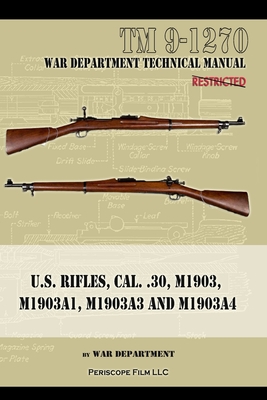U.S. RIfles, Cal. 30, M1903, M1903A1, M1903A3, M1903A4

U.S. RIfles, Cal. 30, M1903, M1903A1, M1903A3, M1903A4
The greatest of all U.S. military issue, bolt action rifles, the M1903 Springfield saw front line service in WWI and WWII, and limited service in the Korean War and Vietnam. Officially known as the United States Rifle, Caliber .30-06, Model 1903, the Springfield is a five-round magazine, repeating rifle. The origins of the weapon can be traced back to the 1898 Spanish-American War, and the effective and deadly use of the Mauser M1893 by Spanish troops. It was clear that these weapons outclassed American standard-issue Springfield Krag-Jorgensen rifles. In the wake of that conflict, the U.S. military decided to rapidly adopt the "Mauser system" and purchased a license from Germany for $200,000. The resulting weapon was a long gun with accuracy at range and a reliable internal mechanism. It was fairly conventional in design, except that the weapon could be considered a hybrid, in that it was capable of serving both as a service gun and a carbine. The M1903 was designed, developed and built at the Springfield Armory, and so took on the "Springfield" designation. Initially designed to use the 30-03 cartridge, the weapon was modified to accept a pointed bullet design known as the "Cartridge, Ball, Caliber 30, Model of 1906". This bullet became known as the ".30-06" or ".30-06 Springfield". The M1903 first saw combat during the Philippine-American War, and by the outbreak of WWI was the U.S. Army's standard infantry rifle. It began to be supplanted by the semi-automatic M1 Garand in 1936, but due to production shortages and other issues, it was still used extensively in WWII. Post-war it remained in service primarily secondary uses such as guard duty, as a drill rifle, and for sniper duty. Today the M1903 Springfield remains popular as a civilian firearm, historical collector's piece, a competitive shooting rifle, and as a military drill rifle. Produced by the U.S. Army in 1944, this technical manual was created for ordnance maintenance personnel. It contains detailed instructions for the disassembly, assembly, inspection, maintenance and repair of the M1903, M1903A1, M1903A3, M1903A4 (snipers) as well as the associated M1905 and M1 bayonets and scabbards, slings, and M73B1 telescopic sight.
PRP: 110.05 Lei
Acesta este Prețul Recomandat de Producător. Prețul de vânzare al produsului este afișat mai jos.
99.05Lei
99.05Lei
110.05 LeiLivrare in 2-4 saptamani
Descrierea produsului
The greatest of all U.S. military issue, bolt action rifles, the M1903 Springfield saw front line service in WWI and WWII, and limited service in the Korean War and Vietnam. Officially known as the United States Rifle, Caliber .30-06, Model 1903, the Springfield is a five-round magazine, repeating rifle. The origins of the weapon can be traced back to the 1898 Spanish-American War, and the effective and deadly use of the Mauser M1893 by Spanish troops. It was clear that these weapons outclassed American standard-issue Springfield Krag-Jorgensen rifles. In the wake of that conflict, the U.S. military decided to rapidly adopt the "Mauser system" and purchased a license from Germany for $200,000. The resulting weapon was a long gun with accuracy at range and a reliable internal mechanism. It was fairly conventional in design, except that the weapon could be considered a hybrid, in that it was capable of serving both as a service gun and a carbine. The M1903 was designed, developed and built at the Springfield Armory, and so took on the "Springfield" designation. Initially designed to use the 30-03 cartridge, the weapon was modified to accept a pointed bullet design known as the "Cartridge, Ball, Caliber 30, Model of 1906". This bullet became known as the ".30-06" or ".30-06 Springfield". The M1903 first saw combat during the Philippine-American War, and by the outbreak of WWI was the U.S. Army's standard infantry rifle. It began to be supplanted by the semi-automatic M1 Garand in 1936, but due to production shortages and other issues, it was still used extensively in WWII. Post-war it remained in service primarily secondary uses such as guard duty, as a drill rifle, and for sniper duty. Today the M1903 Springfield remains popular as a civilian firearm, historical collector's piece, a competitive shooting rifle, and as a military drill rifle. Produced by the U.S. Army in 1944, this technical manual was created for ordnance maintenance personnel. It contains detailed instructions for the disassembly, assembly, inspection, maintenance and repair of the M1903, M1903A1, M1903A3, M1903A4 (snipers) as well as the associated M1905 and M1 bayonets and scabbards, slings, and M73B1 telescopic sight.
Detaliile produsului










